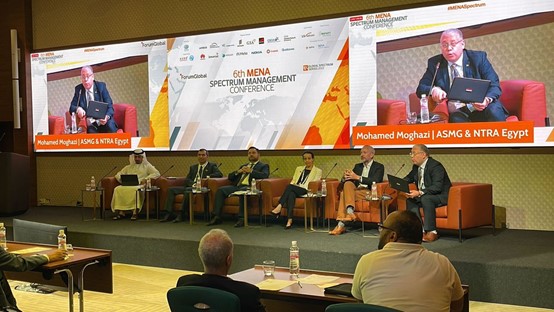
The immersive world of UHD video, XR, and the metaverse now upon us may only seem insignificant from the outside, but it places unique challenges on the underlying network capabilities. Such high bandwidth applications raise the requirements for higher data rates such as 100 Mbps anytime, anywhere, and 1 Gbps in hotspots to support a ubiquitous digital user experience.
Further, users of these services want to take the experiences with them, imposing the need to avail enough capacity to allow continuous and seamless accessibility indoors and outdoors. Fatima Karim, Chairwoman GSA ASMG Spectrum Team, says operators cannot deliver such services cost-efficiently if they do not have access to enough spectrum in mid-bands.
Karim participated in the 6th MENA Spectrum Management Conference in Tunisia last week, an event that brought together regulators, experts, telecom companies, and other ICT players to discuss key spectrum developments ahead of the World Radiocommunication Conference 2023 (WRC-23).

WRC-23 is a potentially crucial marker in the evolution of 5G. During WRC-19 in 2019, the ITU agreed to establish an agenda item to study 6GHz targeting IMT identification of 6425-7125 MHz in WRC-23 in 2023. Participants at next year’s event will seek some agreement on global spectrum harmonization, which enables international roaming, interoperability and global markets for telecom equipment.
The event will also guide MENA regulators, who must balance competing demands for prized spectrum, particularly between licensed (5G) and unlicensed (WiFi). The WiFi industry continues to lobby regulators to make the 6GHz spectrum available to WiFi users, saying wireless is “a necessary complement to delivering 5G, an important tool bringing communication networks to underserved areas, and a strong contributor to global economies.”
While we agree that WiFi has a crucial role in enabling digital experiences for consumers and industry, it falls short when the same users are exposed to 5G. During her session, Karim gave the example of South Korea, where offload from telco networks to wireless access points has constantly decreased for the last two and half years, including during the pandemic. This shows that in markets with enough capacity allocated to 5G networks, people are reducing their offload to WiFi or even wholly stopped switching to wireless to take advantage of a better user experience over 5G. She adds that it is more convenient for people to stay on one technology in these markets.
Experts, therefore, recommend allocating the entire 6GHz to 5G as the most optimal driver for MENA’s digital economy. Indeed, initial 5G applications have demonstrated the technology’s tremendous potential to power economic growth for the frontrunners. In the long-term, more capacity in mid-band will be needed as 5G evolves, with 6GHz the ideal frequency to accommodate future growth. Such developments will bring massive opportunities for regional economies; research shows that mid-band 5G (3.5GHz – 6GHz) could deliver $610 billion in GDP growth in 2030 (63.5% of the total 5G benefit).
Otherwise, allocating a 6GHz band for unlicensed/WiFi will lead to an imbalance in mid-bands assignment to unlicensed versus licensed applications and represent a significant opportunity loss for 5G technologies and economies in the future. Further, such a decision would be practically irreversible when 5G use cases surge as expected and require more capacity.
In any case, any gaps in wireless connectivity can be resolved within existing parameters. WiFi already has access to over 600MHz of spectrum within the 2.4 GHz and 5 GHz bands in many MENA countries. If additional spectrum in mid bands is required, then the lower 6GHz band offers an excellent opportunity to double the spectrum.
The MENA countries are making considerable strides in developing their digital economies. Most countries in the region have prioritized investing in technology to accelerate post-pandemic economic recovery, reenergizing already ambitious digital transformation goals set out in various national visions.
Priorities in the next decade should, therefore, include introducing and expanding 5G coverage to power the fourth industrial revolution while addressing challenges such as the digital divide. With that in mind, supporting IMT identification allows regulators to take the proper steps after WRC-23, depending on their specific situation. Speaking at the MENA conference, Jinane Karam, Senior Manager for Government Affairs at Qualcomm, said regulators should update their approach to tackle challenges and take full advantage of emerging opportunities.
The MENA region is on the verge of an economic transformation powered by digital technologies. Favorable government policies have been instrumental in current success. Future growth will be determined partly by how governments handle the spectrum equation.
